The Waxing Moon Passes Planets, Comets Continue, Gas Giants Glow, and Algol Grows Dim
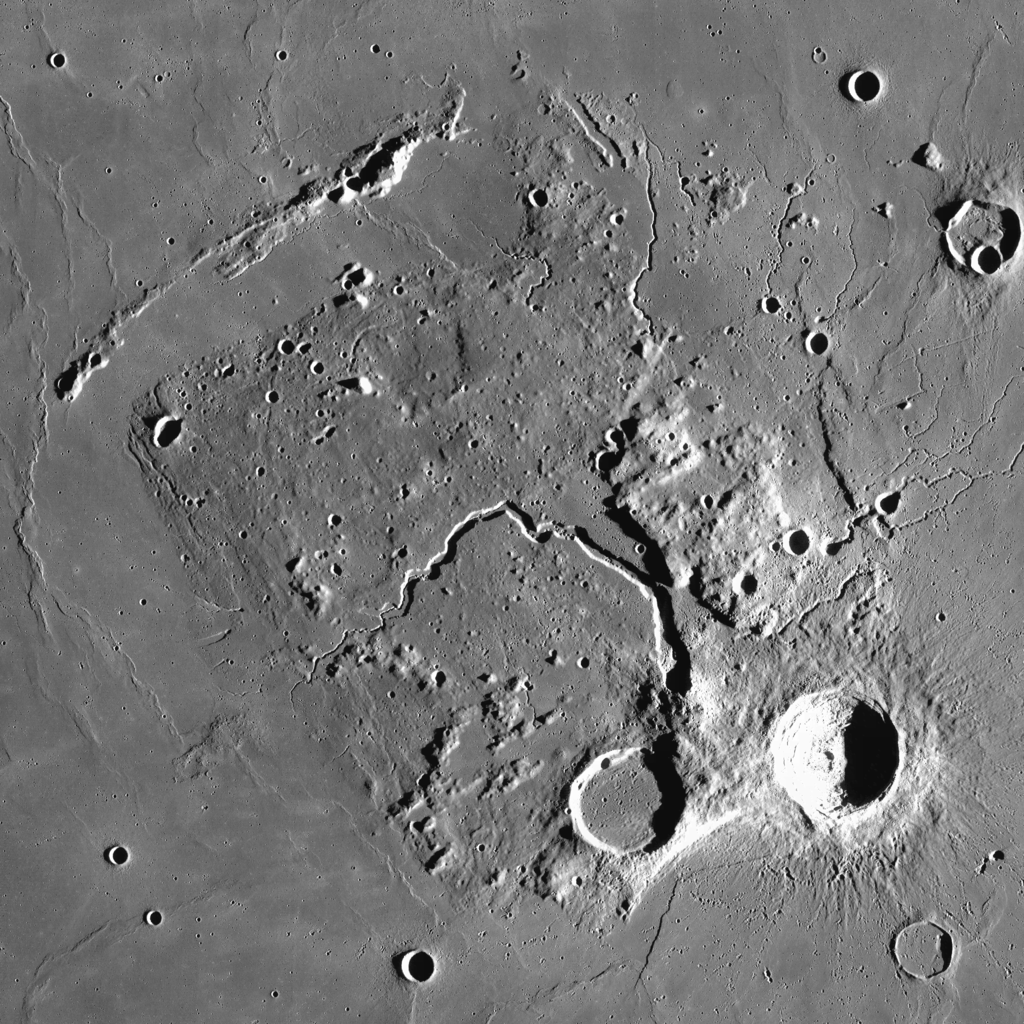
This image taken by the Lunar Reconnaissance Orbiter shows the fascinating Aristarchus Plateau. The crater Aristarchus at lower right is very prominent, and can be seen even with unaided eyes as a very bright patch. To its left is the similar-sized, but darker crater Herodotus. Vallis Schröteri, the largest sinuous rille on the moon, starts at a broad section near Herodotus, called the Cobra’s Head, and winds to the north, tapering along the way. All of those features sit within the elevated, rough-surfaced, diamond-shaped plateau.
Happy Moongazing!
Here are your Astronomy Skylights for the week of November 19th, 2023 by Chris Vaughan. Feel free to pass this along to your friends and send me your comments, questions, and suggested topics. You can also follow me on Twitter as @astrogeoguy! Unless otherwise noted, all times are expressed in Eastern Time. To subscribe to these emails please click this MailChimp link.
If you’d like me to bring my Digital Starlab portable inflatable planetarium to your school or other daytime or evening event, or deliver a session online, contact me through AstroGeo.ca, and we’ll tour the Universe, or the Earth’s interior, together! My book with John A. Read entitled 110 Things to See With a Telescope is a guide to viewing the deep sky objects in the Messier List – for both beginners and seasoned astronomers. DM me to order a signed copy!
The moon will grow ever brighter in evening this week, passing near to four planets as it rolls away from the sun. One binoculars and two telescope comets are available to see or image. Jupiter and Saturn shine brightly in evening and late-night, while Mercury lurks in the west after sunset and Venus gleams in the east before sunrise. And Algol dims at a convenient time. Read on for your Skylights!
Meteor Shower Update
Meteor shower season will take a break for a few weeks. The Northern Taurids shower and the Leonids shower will taper off completely in late November/early December. Meanwhile the terrific Geminids meteor shower will start to develop around now and peak on the moonless night of December 13.
Comets Update
Comet c/2023 H2 (Lemmon) has passed its peak size and brightness, but a number of astronomers have recently estimated its magnitude value to be around 7.5, which is still within reach of binoculars and backyard telescopes under dark skies. (I wrote about that comet’s name last week here.)
Comets are speedy! This one will move by more than a fist’s diameter over the course of this week, travelling from upper right to lower left (or celestial southeast) between the southerly constellations of Piscis Austrinus (the Southern Fish) and Microscopium (the Microscope). Those constellations are highest in the south around 6 pm local time, so you’ll want to look for the comet as soon as the sky darkens. Unfortunately the comet won’t be close to any bright stars this week, but it will be located about 1.7 fist diameters to the right of the very bright star Fomalhaut (or Alpha Piscis Austrini). The first quarter moon will shine a palm’s width above the comet tonight (Sunday). The moon will move farther from that part of the sky each night, but it will be steadily brightening, too – somewhat spoiling our comet-viewing.
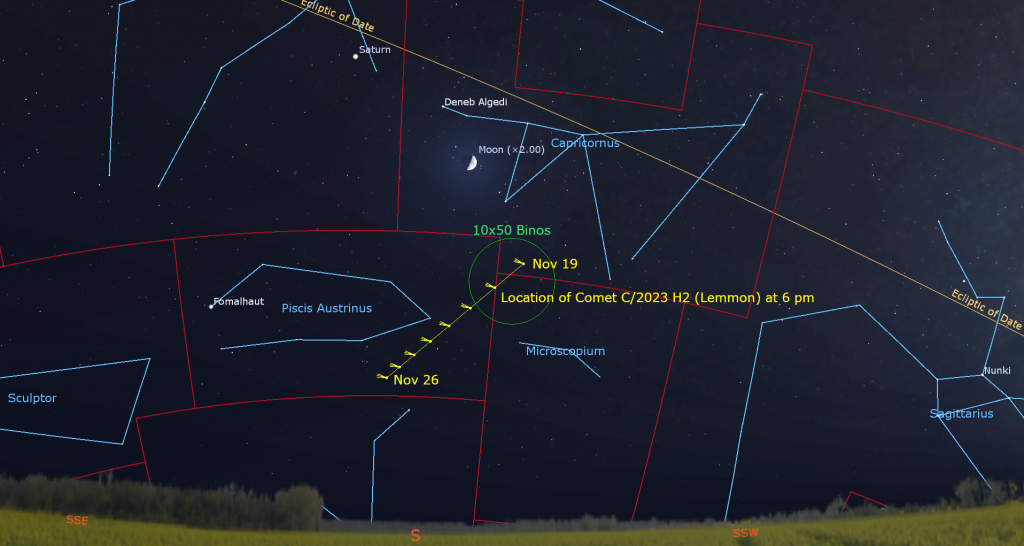
Expect the comet to appear as a faint, grey, fuzzy patch. Comets frequently look greenish when viewed in a large backyard telescope or in a long exposure photograph. That colour is produced when diatomic carbon released from the comet’s icy snowball core is ionized by solar radiation. You may also discern a small tail extending to the upper left (celestial northeast) from the comet’s coma.
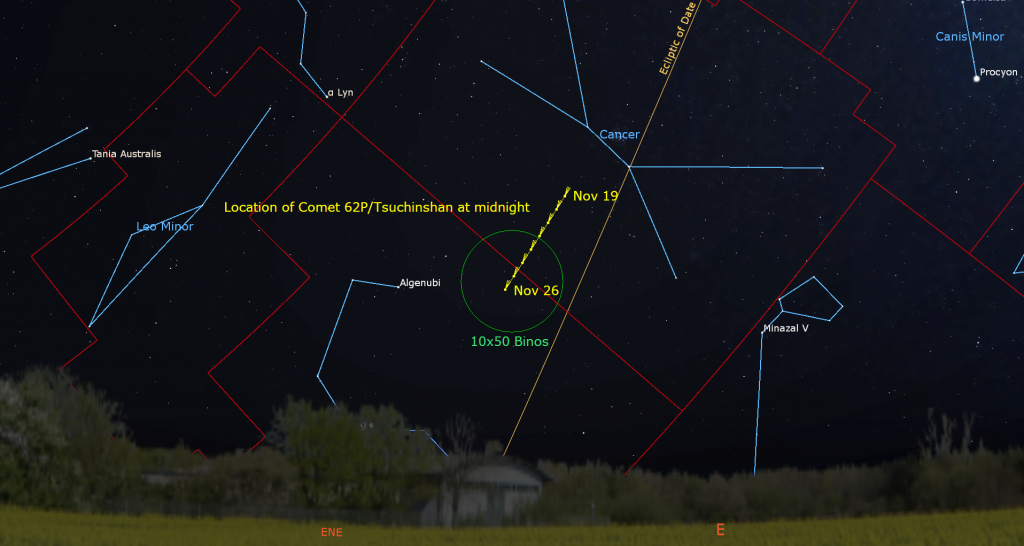
For those of you with larger telescope and/or astrophotography setups, two comets are particularly good in the late-night and pre-dawn sky. Comet 62P/Tsuchinshan is positioned between Leo (the Lion) and Cancer (the Crab), travelling eastward between the medium-bright stars Algenubi and Minazel V aka Zeta Hydrae. The comet is currently around magnitude 10 and is expected to brighten until early January.
Periodic comet 103P/Hartley is also about magnitude 10, though fading. It will be in the southern sky before dawn, travelling slowly downward (southward) through western Hydra (the Snake), about a palm’s width to the right (or 7° to the celestial west-northwest) of the bright star Alphard (i.e., in the direction toward very bright Procyon). It’s also roughly between Venus and Orion’s belt.
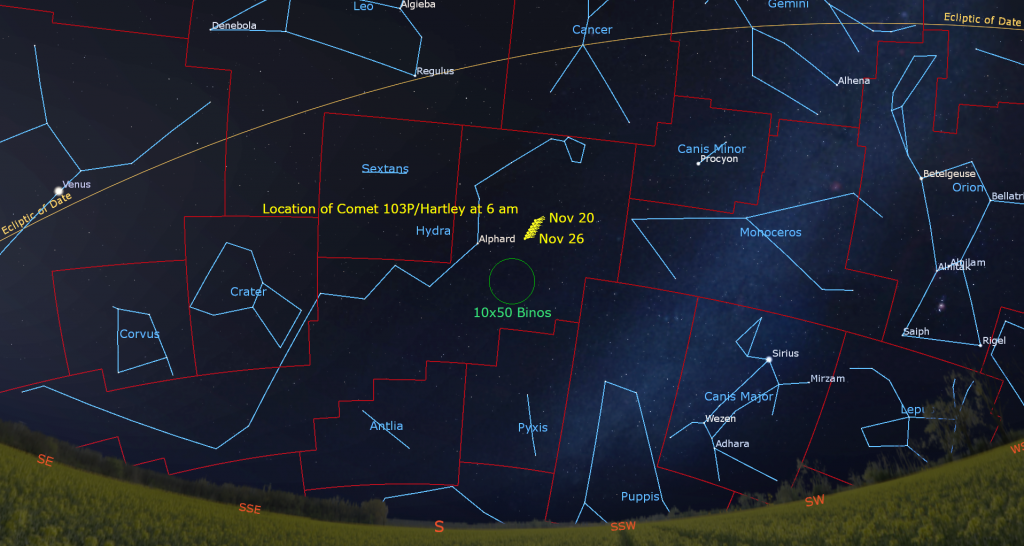
The Moon
This week, the moon will dominate the night sky worldwide while it waxes from first quarter to full. Get ready for some lunar-planetary conjunctions, too! From tonight (Sunday) to Saturday, the moon will visit four planets in succession – Saturn, Neptune, Jupiter, and Uranus.
Today (Sunday) the nearly half-illuminated moon will rise after lunch. As the sky darkens at dusk it will be perched in the southern sky, with the yellowish dot of Saturn positioned a generous fist’s diameter to its upper left and the faint tail stars of Capricornus (the Sea-Goat) above it. The stars marking the critter’s head will shine to the moon’s upper right. You’ll likely need binoculars to see them against the moonlight, though.
The moon will complete the first quarter of its 29.53-day trip around the Earth on Monday at 5:50 am EST, 2:50 am PST, and 10:50 Greenwich Mean Time. At first quarter, the moon’s 90 degree angle from the sun causes us to see it half-illuminated on its eastern side. Lunar phases occur independently of Earth’s rotation, so only folks in Asia and the western Pacific Ocean regions will see the moon when it’s at that phase this month. When those of us in the Americas see the moon starting on Monday afternoon, it will already slightly gibbous.
After 24 hours of motion, Monday night’s moon will shine less than a palm’s width to Saturn’s lower left (celestial east) in Aquarius (the Water-Bearer). As the moon waxes each night, the terrain alongside the pole-to-pole terminator will be spectacular under any magnification. But as the moon gets mainly full after mid-week, its topography will look less dimensional and more flat, even along the terminator. That’s because the shadows being cast by features nearer to its western limb will be partially blocked by the peaks, crests, and crater rims in front of them.
The bright moon will spend Tuesday in Aquarius. Neptune will be located about a palm’s width to the moon’s upper left, but the distant planet will be too faint to see. From Wednesday to Friday, the moon will surf along the crooked border between Pisces (the Fishes) and Cetus (the Whale or Sea-Monster) below them.
On Thursday night, the terminator will land just to the left of Mare Humorum, the round, dark patch in the moon’s southwestern quadrant. It is a basin formed during the moon’s Nectarian Period approximately 3.9 million years ago. If the air is steady, views in a telescope on the nights before full moon each month will show curved wrinkle ridges near the eastern rim of Humorum’s lava-flooded sector, the parallel curves of Rimae Hippalus outside its eastern border, and the prominent Rupes Liebig and Rimae Doppelmayer on its western rim. A darker region of the basin floor along the southwestern edge is composed of volcanic glasses and ash deposits. On the basin’s northern rim lies the large floor-fractured crater Gassendi.
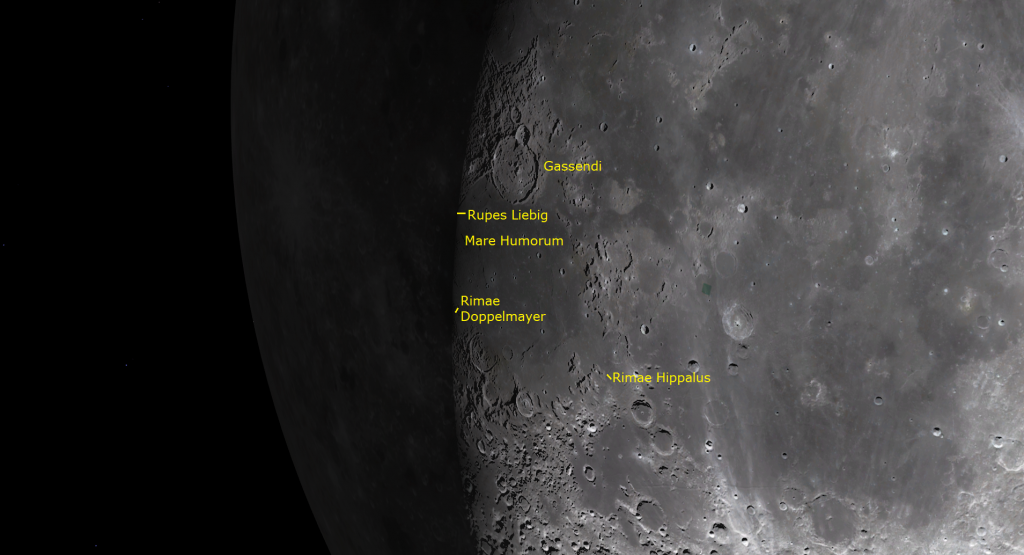
On Friday night, use your binoculars or telescope to look at the very bright spot of crater Aristarchus gleaming near the terminator near the moon’s upper-left (western) rim and surrounded by a sea of dark grey rock. That small crater occupies the southeastern corner of a diamond-shaped plateau that is one of the most colorful regions on the moon. NASA orbiters have detected high levels of radioactive radon there. Use a telescope and high magnification to view features like the large, sinuous rille named Vallis Schröteri. Its snake-like form begins between Aristarchus and next-door crater Herodotus and slithers across the plateau. I never tire of looking at it!
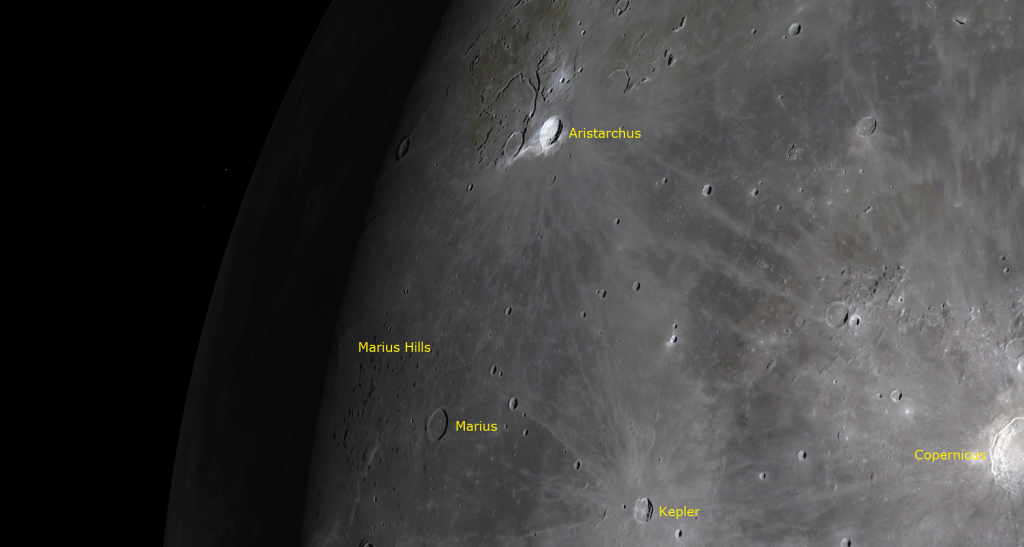
The small crater Marius is located a short distance below Aristarchus. Watch for a swarm of bumps, the Marius Hills, above it, and subtle wrinkles running up-down to Marius’ left. The large craters Copernicus and Kepler to Aristarchus’ lower right are surrounded by large, ragged ray systems – composed of ejecta from their formation and secondary impact craters from that falling debris. The straight arcs forming the ray of the crater Tycho, which is located in the moon’s lower (southern) region, spread far across the moon.
The moon’s final visit with the evening planets this month will occur on Saturday night, when the very bright, 98%-illuminated moon will shine several finger widths to the upper right (or 4 degrees to the celestial west) of Uranus in Aries (the Ram). While magnitude 5.6 Uranus can be seen easily in binoculars, especially now while it is recently past opposition, the moonlight will overwhelm the planet. Instead, note that Uranus is positioned a little closer to the Pleiades star cluster and a little farther from Jupiter, and seek out the ice giant planet when the moon has left its vicinity a few nights later.
Another interesting but, alas, not visually appealing, meet-up will happen next Sunday night in the Americas. The very bright moon, only a few hours ahead of its full phase, will shine just a thumb’s width below (or celestial southeast of) the Pleiades star cluster in Taurus (the Bull). Try hiding the full moon just below your binoculars’ field of view and see if you can spot any of the Seven Sisters’ stars.
The six crewed Apollo Missions were sent to different regions of the moon in order to carry out experiments and to bring back rock samples that help us determine the age and composition of the moon’s surface. For safety reasons, Apollo 11 was sent to the flat and relatively featureless terrain of Mare Tranquillitatis “Sea of Tranquility” near the moon’s equator. Later missions landed in more rugged regions with complex geology. When the moon approaches its full phase, all of the sites where the astronauts explored are illuminated by sunlight, but no telescope on Earth is strong enough to see the equipment they left on the moon.

The moon will look full on Sunday night in the Americas. Only a sliver along its left-hand (lunar western) edge will be “missing”. I’ll highlight additional interesting aspects of the full moon next week.
The Planets
The planet Mercury will be lurking above the southwestern horizon for a short time after sunset this week, but its position below a very slanted ecliptic will hold it too low to be seen easily from mid-northern locales. If you live in the southern USA, or in the tropics, or in the Southern Hemisphere, you can seek out Mercury’s brightening, magnitude -0.4 speck above the sunset point on the horizon after the sun has completely set – but don’t search with binoculars or a telescope until the sun is gone from view. As it swings wider from the sun, Mercury will get a little easier to see every night.

The yellowish dot of Saturn will emerge from the evening twilight in the lower part of the southern sky at dusk. It will culminate in the south around 6:30 pm local time (its best telescope viewing time) and then sink westward to set before midnight. Although Saturn is positioned within the borders of Aquarius, most of the Water-Bearer’s stars are arrayed off to Saturn’s upper left (or celestial east). The faint stars of Capricornus (the Sea-Goat) are to Saturn’s lower right (or west). On tonight and Monday, the waxing moon will shine near Saturn.
Any size, style, or brand of telescope will show Saturn’s beautiful rings. If your optics are of good quality and the air isn’t too turbulent, try to see the Cassini Division, a narrow gap that separates the large outer A Ring from the large inner B Ring. I wrote more about the rings here. Good binoculars can hint at the shape of Saturn’s rings, too.
From here on Earth, Saturn’s axial tilt of 26.7° lets us see the top of its ring plane, and allows its brighter moons to array themselves above, below, and alongside the planet. Saturn’s largest and brightest moon Titan never wanders more than five times the width of Saturn’s rings from the planet. The much fainter moon named Iapetus can stray up to twelve times the ring width during its 80-day orbit of Saturn. The next brightest moons Rhea, Dione, Tethys, Enceladus, and Mimas all stay within one ring-width of Saturn.
During this week, Titan will migrate counter-clockwise around Saturn, moving from the lower right of Saturn (celestial southwest east) tonight to just to the upper right of the planet (celestial northwest) next Sunday night. At midweek, Titan will venture well to the west of Saturn. (Remember that your telescope will probably flip the view around.) The rest of the moons will be tiny specks. You may be surprised at how many of them you can see through your telescope if you look closely.
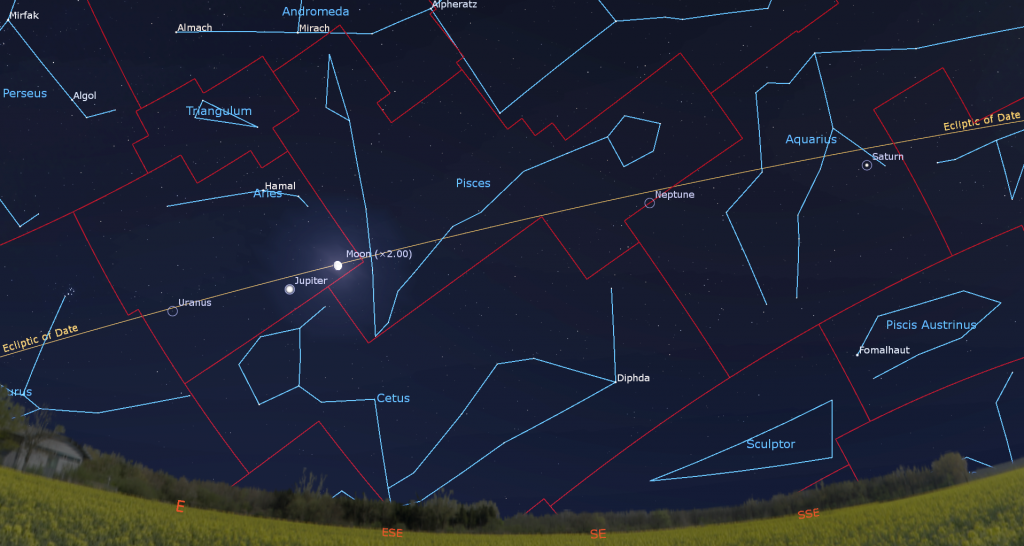
Saturn is preceding the far fainter ice giant planet Neptune across the sky each night. This week Neptune will be located 2.5 fist diameters to Saturn’s upper left, or 25° to its celestial northeast. The diurnal rotation of the sky – the way things tilt as they cross from east to west – will cause Neptune to be lifted increasingly higher than Saturn until they set. Even though magnitude 7.8 Neptune is 650 times fainter than Saturn, it is visible in backyard telescopes, especially when the blue planet is highest in the hours surrounding 8 pm local time. Good binoculars can show Neptune if your sky is very dark, but the bright moon will spoil the fun this week, especially on Tuesday-Wednesday when the gibbous moon will cruise past Neptune.
The giant planet Jupiter, 29 times brighter than Saturn, will gleam above the eastern horizon after sunset and then catch your eye while it crosses the sky all night long. Jupiter will climb to a position relatively high in the southern sky in late evening and then set in the west by 6 am local time. The big planet will look best in a telescope while it is higher, between 6 pm to 3:30 am each night. Jupiter will not suffer much from the bright moon shining beside it on Thursday-Friday. Hamal and Sheratan the two brightest stars of Aries (the Ram), are shining a generous fist’s diameter above Jupiter this year.
Binoculars will show you Jupiter’s four Galilean moons in a line flanking the planet. Named Io, Europa, Ganymede, and Callisto in order of their orbital distance from Jupiter, those moons complete orbits of the planet every 1.7, 3.6, 7.2, and 16.7 days, respectively. If you see fewer than four moons, then one or more of them is crossing in front of or behind Jupiter, or hiding in Jupiter’s dark shadow – or two of the moons are very close together or occulting one another. All four moons will be gathered to Jupiter’s left on Thursday.
A small, but decent quality telescope can show you Jupiter’s dark belts and light zones, which are aligned parallel to its equator. With a better grade of optics, Jupiter’s Great Red Spot, a cyclonic storm that has raged for hundreds of years, becomes visible for several hours when it crosses the planet every 2nd or 3rd night. For observers in the Americas, the GRS will cross Jupiter’s disk in mid-evening Eastern Time Monday, Wednesday, and Saturday. It’ll appear around in late night Tonight (Sunday), Tuesday, Friday, and next Sunday, and before dawn on Tuesday, Friday, and next Sunday morning. If you have any coloured filters or nebula filters for your telescope, try enhancing the spot with them.
From time to time, the small, round, black shadows cast by Jupiter’s Galilean moons become visible in amateur telescopes when they cross (or transit) the planet’s disk. On Monday evening, November 20, Io will lead its shadow across Jupiter from 9:17 to 11:25 pm EST (or 02:17 to 04:25 GMT). Ganymede’s large shadow will travel across Jupiter’s southern latitudes on Friday evening, November 24 from 9:08 pm to 10:42 pm EST (or 02:08 to 03:42 GMT). Each of those moons will be in view when it moves off Jupiter at the end of its shadow transit. (These times may vary by a few minutes, and other time zones of the world will have their own crossings.)
Uranus has been following Jupiter across the sky every night this year. This week the blue-green ice giant planet will be positioned a generous fist’s diameter to Jupiter’s lower left (or 12.5° to the celestial east), on the Aries side of its border with Taurus. The diurnal rotation of the sky will lift Uranus to the same height as Jupiter around 10:45 pm local time and then higher still later. The bright little Pleiades star cluster will be located a similar distance to Uranus’ upper left (or 10° to the celestial northeast).
Recently past opposition and peak visibility for this year, Uranus will shine at magnitude 5.63 as it crosses the sky all night long, making it readily visible in binoculars and backyard telescopes. Some people have been able to spot Uranus with their unaided eyes, but the bright moon nearby on the coming weekend will prevent that. Uranus small, blue-green dot will best be seen in a telescope between 6:30 pm and 5 am local time earlier this week. Uranus has been moving slowly retrograde westwards through southeastern Aries. Uranus’ location two finger widths to the lower right (or 2 degrees south) of the medium-bright stars Botein and Epsilon Arietis will aid in your binoculars search.
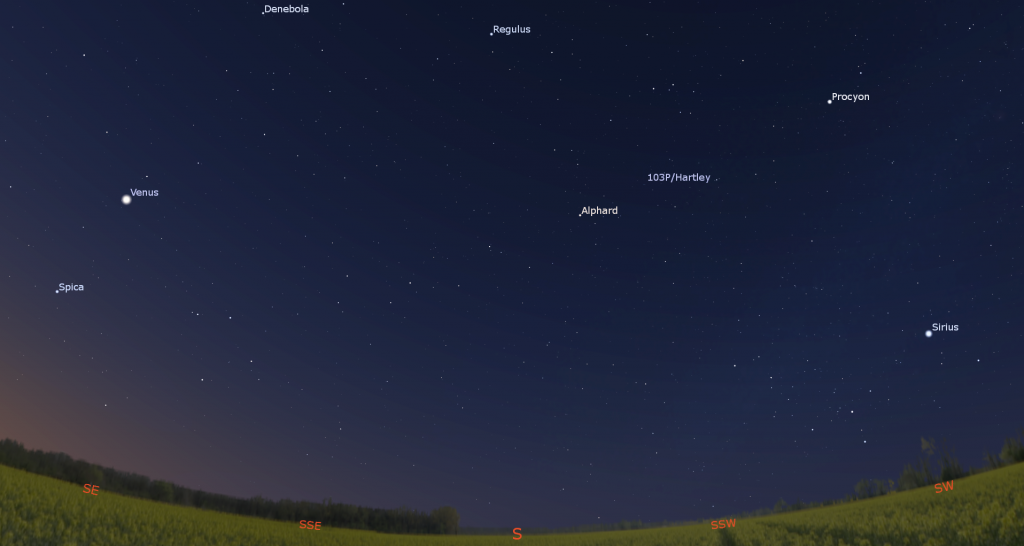
Brilliant Venus will be rising among the stars of Virgo (the Maiden) at about 3:30 am local time this week. If you head outside by about 6:30 am on a clear morning, Sirius, the brightest star in the night sky, will mirror Venus, the “Morning Star” in the southwestern sky. Due to its swing sunward, Venus will shift a little lower each morning. Over the course of this week, it will cross diagonally through Virgo. Viewed through a telescope, our hot sister planet will show a waxing gibbous disk spanning 18.5 arc-seconds.
Algol Fades in Brightness
The star Algol in the constellation of Perseus (the Hero) represents the glowing eye of Medusa from Greek mythology. Also designated Beta Persei, it is among the most accessible variable stars for skywatchers. During a ten-hour period that repeats like clockwork every 2 days, 20 hours, and 49 minutes, Algol dims noticeably and re-brightens by about a third when a fainter companion star with an orbit nearly edge-on to Earth crosses in front of its much brighter primary, reducing the total light output we perceive. Astronomers call that arrangement an eclipsing binary star.
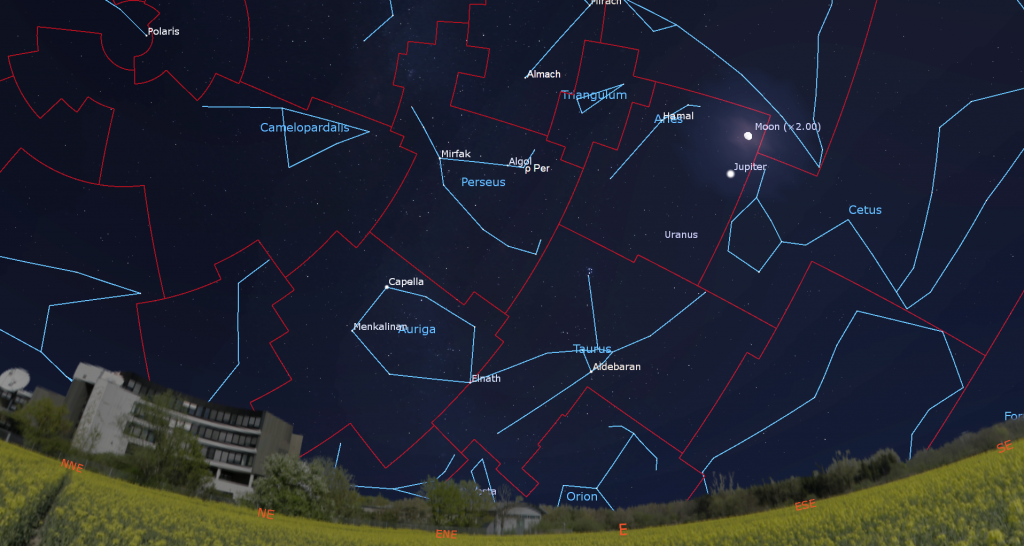
Algol normally shines at magnitude 2.1, similar to the nearby star Almach (aka Gamma Andromedae). But while fully dimmed, Algol’s brightness of magnitude 3.4 is almost identical to Rho Persei (or Gorgonea Tertia or ρ Per), the star sitting 2.25 degrees to Algol’s south. On Friday evening, November 24 at 7:39 pm EST (or 00:39 Greenwich Mean Time on November 25), Algol will fade to its minimum brightness. At that time it will be located halfway up the eastern sky. Five hours later the star will return to full intensity from a perch nearly overhead in the west. Anyone can look up their own Algol dimming times at https://skyandtelescope.org/observing/the-minima-of-algol/.)
Public Astronomy-Themed Events
Every Monday evening, York University’s Allan I. Carswell Observatory runs an online star party – broadcasting views from four telescopes/cameras, answering viewer questions, and taking requests! Details are here. They host in-person viewing on the first clear Wednesday night each month. Other Wednesdays they stream views online via the observatory YouTube channel. Details are here.
Taking advantage of the crescent moon in the sky this week, the RASC Toronto Centre astronomers will hold their monthly City Sky Star Party in Bayview Village Park (a short walk from the Bayview TTC subway station), starting after dusk on the first clear weeknight this week (Mon, Tue or Thu only). Check here for details, and check the banner on their website home page or Facebook page for the GO or NO-GO decision around 5 pm each day.
On Wednesday evening, November 22 at 6:30 pm in Room A/B of the Central Library in Richmond Hill, RASC astronomers will present a talk about the gas giant planets Jupiter and Saturn, and the ice giants Uranus and Neptune. Attendees will get tips for observing these planets from their own backyard, and if the skies are clear, use telescopes to observe the planets after the lecture! More information and the registration link is here.
On Friday, November 24 from 7 to 9 pm EST, the in-person Astronomy Speakers Night program at the David Dunlap Observatory in Richmond Hill, Ontario will feature Dr. Mary-Helen Armour. She will speak on Impact Structures in Ontario.After the presentation, participants will tour the observatory and see a demonstration of the 74” telescope pointed to an interesting celestial object for the visitors to view (weather permitting). More information is here and the registration link is at ActiveRH.
Spend an afternoon in the other dome at the David Dunlap Observatory! On Saturday afternoon, November 25, visitors 6 years old and up can join me in my Starlab Digital Planetarium for an interactive journey through the Universe at DDO. We’ll tour the night sky and see close-up views of galaxies, nebulas, and star clusters, view our Solar System’s planets and alien exo-planets, land on the moon, Mars – or the Sun, travel home to Earth from the edge of the Universe, hear indigenous starlore, and watch immersive fulldome movies! Ask me your burning questions, and see the answers in a planetarium setting – or sit back and soak it all in. Please note that all guests will sit on a clean floor. A registered adult must accompany all registered participants under the age of 16. We run one session at 1 pm and another one at 2:45 pm. More information and the registration links are here.
On Sunday afternoon, November 26 from 12:30 to 1 pm EDT, head to the David Dunlap Observatory for in-person DDO Sunday Sungazing. Safely observe the sun with RASC Toronto astronomers! During the session, which is for ages 7 and up, a DDO Astronomer will answer your questions about our closest star – the sun! Registrants will be given an eclipse viewer, learn how the sun works and how it affects our home planet, view the sun through solar telescopes, weather permitting, and visit the giant 74” telescope. More information is here and the registration link is here.
Keep your eyes on the skies! I love getting questions and requests. Send me some!